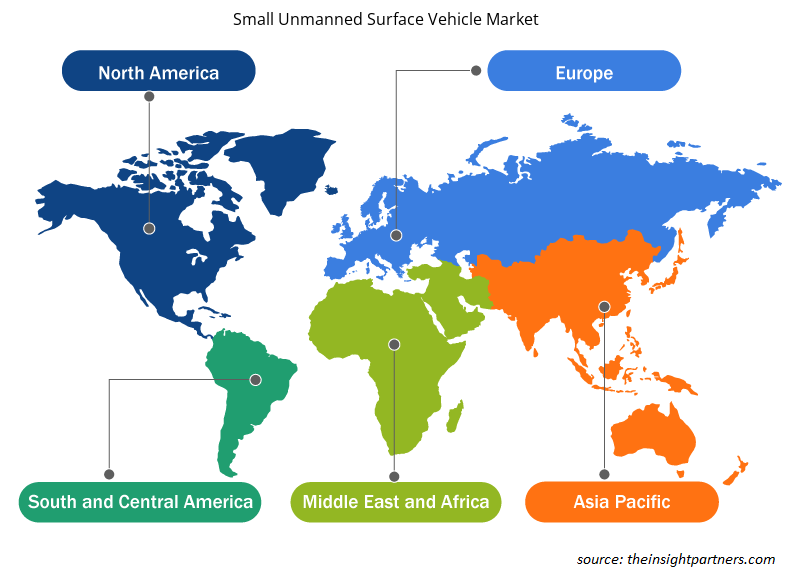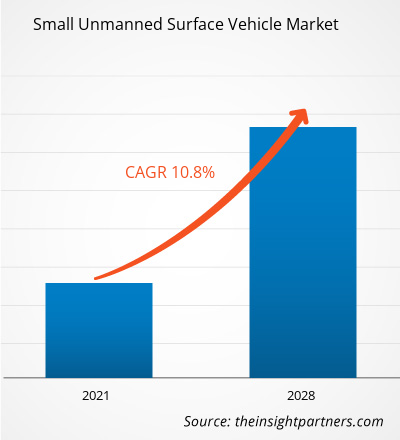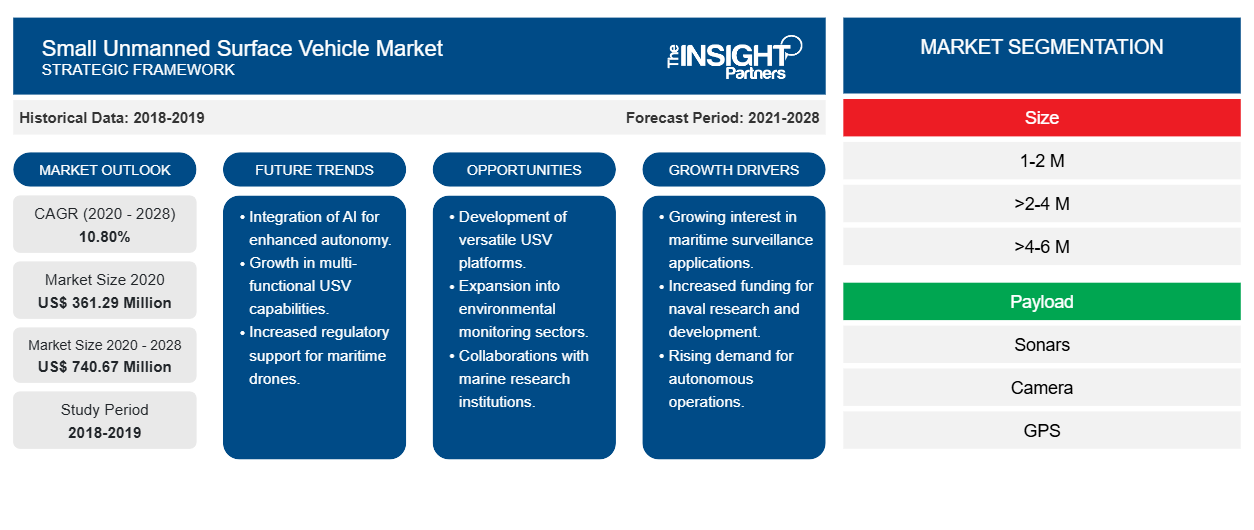[研究报告] 小型无人水面艇市场预计将从 2021 年的 3.6129 亿美元增长到 2028 年的 7.4067 亿美元;预计 2021 年至 2028 年的复合年增长率为 10.80%。
推动小型无人水面舰艇市场增长的主要因素包括对水质监测海洋数据测绘需求的激增以及对沿海水域巡逻和反潜作战行动需求的增加。此外,在预测期内,对无人海上勘探技术的持续投资将为市场供应商创造巨大的机会。随着沿海开发的增长,海域变得越来越拥挤,国家和非国家行为者利用海洋进行各种活动,这加剧了这一现象。授权高度重视海上监视和保护。因此,部署了无人驾驶车辆等现代资产,以降低人类生命风险并通过进入其他领域来减轻与敌人的接触。此外,数字连接的激增应用是无人海洋系统增长的主要因素。因为连通性对于现代网络化海上和海底部队起着至关重要的作用。主要国家的国防部门正在大量投资于连接海底传感器、水下平台和水面资产与空中系统和天基资产的开发,以及网络作战。预计这一因素将引发无人资产的不断扩大,以应对任何潜在的对手威胁。因此,对深海勘探技术开发的持续投资预计将在未来几年为无人水下航行器和无人水面航行器市场参与者提供大量盈利机会。
定制此报告以满足您的需求
您可以免费定制任何报告,包括本报告的部分内容、国家级分析、Excel 数据包,以及为初创企业和大学提供优惠和折扣
-
获取此报告的关键市场趋势。这个免费样品将包括数据分析,从市场趋势到估计和预测。
COVID-19 疫情对小型无人水面车市场的影响
由于各国实施封锁措施,2020 财年 COVID-19 疫情几乎席卷了全球所有行业。这些限制措施扰乱了不同行业的供应链,并导致行业供需缺口。由于疫情,对自动化技术的投资减少,对 2020 年北美小型无人水面车市场产生了负面影响。然而,一项研究显示,预计到 2022 年第二季度,该市场将恢复增长。
在水文作业方面,COVID-19 疫情并没有真正严重影响自动化技术的采用。2020 年前两个季度,海洋工业暂停运营,影响了北美地区对无人水面舰艇的需求。此外,过去几年对无人系统的需求有所增加,这已成为整个海洋工业运营的一种趋势。例如,由于国防工业对采用自主无人驾驶车辆的投资不断增加,国防领域已成为北美增长最快的无人系统市场之一,尤其是在美国。这一因素推动了 2020 年小型无人水面舰艇市场的增长。
市场洞察 – 小型无人水面航行器市场
海洋数据测绘和水质监测需求激增
精确的海底地图对于导航、运输、渔业、电信和海上能源以及了解与天气和气候有关的洋流和物理特性至关重要。远程自动驾驶汽车可以以环保的方式绘制海洋地图。此外,使用自动驾驶汽车进行海洋数据测绘所需的人力和成本比传统的船舶测绘要少。政府组织和私人机构正在大量投资制造和开发用于海洋数据测绘的先进高效的小型无人水面航行器。因此,全球对小型 USV 的需求日益增加。这些车辆用于各种应用,例如海洋数据收集和测绘、水质监测以及浅水和港口保护。
水污染是一个严重的问题,尤其是在发展中国家。因此,水质监测已成为水保护的关键。随着工业和城镇化的快速发展,工业和生活污水严重影响了世界各地的淡水资源,尤其是在发展中国家。它极大地影响了人类的生存条件。新的测量技术,如船载测量和物联网系统,被用于监测水质。
基于尺寸的洞察
根据规模,小型无人水面航行器市场细分为 1-2 M、>2-4 M 和 >4-6 M。1-2 M 细分市场在 2021 年占据了最大的市场份额。
小型无人水面航行器市场的参与者主要致力于开发先进、高效的产品。
- 2021 年 5 月,Seabed 宣布与 Waterlinked 建立新的经销权。Waterlinked 以世界上最小的 DVL 及其水下 GPS 和海底调制解调器而闻名。
- 2021 年 1 月,Seabed 宣布与 Hemisphere 建立新的经销关系,并成为比荷卢三国的 Hemisphere 官方经销商。Hemisphere GNSS 凭借强大的技术基础,已成为高性能卫星定位和航向市场的领导者。
小型无人水面航行器市场区域洞察
Insight Partners 的分析师已详细解释了预测期内影响小型无人水面舰艇市场的区域趋势和因素。本节还讨论了北美、欧洲、亚太地区、中东和非洲以及南美和中美洲的小型无人水面舰艇市场细分和地理位置。

- 获取小型无人水面航行器市场的区域具体数据
小型无人水面航行器市场报告范围
| 报告属性 | 细节 |
|---|---|
| 2020 年市场规模 | 3.6129亿美元 |
| 2028 年市场规模 | 7.4067亿美元 |
| 全球复合年增长率(2020 - 2028) | 10.80% |
| 史料 | 2018-2019 |
| 预测期 | 2021-2028 |
| 涵盖的领域 |
按尺寸
|
| 覆盖地区和国家 |
北美
|
| 市场领导者和主要公司简介 |
|
市场参与者密度:了解其对商业动态的影响
小型无人水面航行器市场正在快速增长,这得益于终端用户需求的不断增长,这些需求源于消费者偏好的不断变化、技术进步以及对产品优势的认识不断提高等因素。随着需求的增加,企业正在扩大其产品范围,进行创新以满足消费者需求,并利用新兴趋势,从而进一步推动市场增长。
市场参与者密度是指在特定市场或行业内运营的企业或公司的分布情况。它表明在给定市场空间中,相对于其规模或总市场价值,有多少竞争对手(市场参与者)存在。
在小型无人水面航行器市场运营的主要公司有:
- 氢能
- 安德拉数据仪器公司
- AutoNaut 有限公司
- 生态海洋动力
- Liquid Robotics 公司
免责声明:上面列出的公司没有按照任何特定顺序排列。

- 获取小型无人水面航行器市场顶级关键参与者概览
完井市场细分如下:
小型无人水面航行器市场 – 按尺寸
- 1至2个月
- >2–4 个月
- >4–6个月
小型无人水面航行器市场 – 按有效载荷
- 声纳
- 相机
- 全球定位系统
- 卫星通信
- 其他的
小型无人水面航行器市场 – 按应用分类
- 防御
- 科学研究
- 灾害管理
- 水文地理
- 其他的
小型无人水面航行器市场 – 按地区划分
-
北美
- 我们
- 加拿大
- 墨西哥
-
欧洲
- 德国
- 法国
- 意大利
- 英国
- 俄罗斯
- 欧洲其他地区
-
亚太地区 (APAC)
- 中国
- 印度
- 日本
- 韩国
- 泰国
- 亚太地区其他地区
-
中东和非洲
- 南非
- MEA 其他地区
-
南美洲
- 巴西
- 阿根廷
- SAM 其余部分
小型无人水面舰艇市场——公司简介
- 氢能
- 安德拉数据仪器公司
- AutoNaut 有限公司
- 生态海洋动力
- Liquid Robotics 公司
- 海峰集团有限公司
- 海床公司
- 海上机器人公司
- 西雷纳
- 奎奈蒂克集团
- 历史分析(2 年)、基准年、预测(7 年)及复合年增长率
- PEST和SWOT分析
- 市场规模、价值/数量 - 全球、区域、国家
- 行业和竞争格局
- Excel 数据集
近期报告
相关报告
客户评价
购买理由
- 明智的决策
- 了解市场动态
- 竞争分析
- 客户洞察
- 市场预测
- 风险规避
- 战略规划
- 投资论证
- 识别新兴市场
- 优化营销策略
- 提升运营效率
- 顺应监管趋势























 获取免费样品 - 小型无人水面艇市场
获取免费样品 - 小型无人水面艇市场